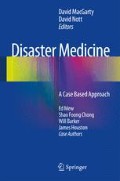Abstract
You are recruited by an NGO operating in a conflict zone to provide medical care for rural villages and to conduct a health needs assessment. Research into humanitarian security in the region paints a bleak picture but you are determined to continue. The NGO plan a low profile approach initially but an increase in the region’s insecurity necessitates the addition of an armed convoy. Despite this one of the supply vehicles hits an improvised exploding device on the road killing several people. The project is cancelled prompting a rethink in the long term security approach and consideration of the financial realities of providing security.
Access this chapter
Tax calculation will be finalised at checkout
Purchases are for personal use only
References
Stoddard A, Harmer A, DiDomenico V. Humanitarian Policy Group Brief 34, Providing aid in insecure environments: 2009 update.
Martin R. NGO field security. Forced Migration Rev. 1999;4:4–7.
Stoddard A, Harmer A. Supporting Security for Humanitarian Action: A review of critical issues for the humanitarian community, Humanitarian Outcomes; Commissioned by conveners of the Montreux X conference; 2010. http://transition.usaid.gov/our_work/humanitarian_assistance/disaster_assistance/consultations/fy2010/supporting_security_humanitarian_action.pdf
The ANSO report, 1–15 June 2011, Issue 75. Kabul: The Afghanistan NGO Safety Office.
International Humanitarian Law and the Geneva Conventions: study guide. Washington, D.C.: The American National Red Cross; 2001
The ICRC in Afghanistan, 01/06/2011 Overview, www.icrc.org./eng/where-we-work/asia-pacific/afghanistan/.
Lillywhite L. Aid for the aid givers, Chatham House, theworldtoday.org (Feb 2011); 2011. p. 12–14.
Lloyd Roberts D. The hazards of the job. In: Matheson JIDM, Hawley A, editors. Making sense of disaster medicine: a hands on guide for medics. London: Hodder Arnold Ltd; 2010.
Alderson A, Farmer B. British doctor and nine others killed in Afghanistan ambush. The Telegraph (07/08/10); 2010.
Boone J, Thompson T. Karen Woo: Selfless doctor gunned down in Afghanistan’s badlands. The Observer (07/08/10); 2010.
Author information
Authors and Affiliations
Corresponding author
Editor information
Editors and Affiliations
Rights and permissions
Copyright information
© 2013 Springer-Verlag London
About this chapter
Cite this chapter
MacGarty, D. (2013). Security for the Humanitarian Worker. In: MacGarty, D., Nott, D. (eds) Disaster Medicine. Springer, London. https://doi.org/10.1007/978-1-4471-4423-6_5
Download citation
DOI: https://doi.org/10.1007/978-1-4471-4423-6_5
Published:
Publisher Name: Springer, London
Print ISBN: 978-1-4471-4422-9
Online ISBN: 978-1-4471-4423-6
eBook Packages: MedicineMedicine (R0)

